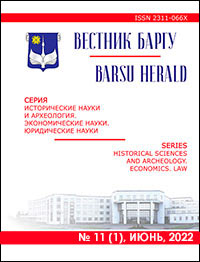CHAIRMEN OF LOCAL EXECUTIVE COMMITTEES OF THE BSSR 1953—1964:MAIN TRENDS, QUALITATIVE AND QUANTITATIVE COMPOSITION
Keywords:
Belorussian SSR; personnel policy; region; district; Soviets; executive committees; chairmenAbstract
The article presents in historical dynamics the qualitative characteristics of the heads of the local vertical of public authorities and management — the chairmen of the executive committees of regional, district and city Soviets of workers' deputies in 1953—1964. It is noted that the mobility of the composition of the chairmen of executive committees in the BSSR was situational in nature and was largely determined by the line for the reorganization of the administrative-territorial structure of the republic: the highest points of this mobility were associated with massive reductions of regions and districts. The changes of the chairmen of the regional executive committees were mainly caused by their transition to a higher position, the chairmen of the district/city executive committees — until 1957 — negative moments (failed to cope with the work, compromised himself), 1958 — positive (promotion, transfer to a similar position, study). The succession of the chairmen of the executive committees took place exclusively among the nomenclature staff. The level of education of the chairmen of the executive committees of the BSSR has significantly increased, but there was an acute
shortage of people with specialized higher education: for district executive committees — agricultural, for city executive committees — technical. The lack of theoretical knowledge in the field of management in the period under study was offset to a certain extent by training in the system of party education.
Ref.: 25 titles.
Downloads
Published
Issue
Section
License
Copyright (c) 2023 Вестник БарГУ Серия "Исторические науки и археология. Экономические науки. Юридические науки"
Это произведение доступно по лицензии Creative Commons «Attribution-NonCommercial» («Атрибуция — Некоммерческое использование») 4.0 Всемирная.
Авторы сохраняют за собой право заключать определенные договорные соглашения, касающиеся неисключительного распространения опубликованной версии работы (например, размещать ее в институциональном репозитории, публикация в книге) со ссылкой на ее первоначальную публикацию в этом журнале.





